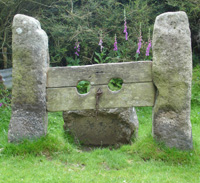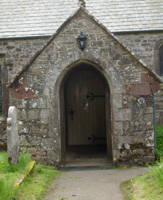
Belstone is a village of some considerable charm, lying just inside the northern extremity
of the Dartmoor National Park above Belstone Cleave, a steep-sided wooded valley concealing
the nascent River Taw shown here with many of the trees displaying their late autumnal
colours.

This first glimpse of the village is revealed on continuing beyond the carpark on the
northern edge.
Traversing the village out to the west leads us into a large expanse of open meadow known
as the Great Green from which we have a splendid view of Cosdon Hill on Dartmoor. The tops
of the trees in the cleave can be seen in the middle distance. Belstone is one of the five
Beacon Villages, each one having a clear view of Cosdon Beacon, as it is also known. To
find out more about the village, visit this page.


Back in 1862 The Gentleman's Magazine found nothing noteworthy on passing through the
village, save what remained of the stocks:
...taking the road from Sticklepath along the beautiful valley of the Skey, we presently
turned off to the right, in order to ascend the mountain ridge to Belstone, a village
standing at a very appreciable height above the level of the sea. We passed nothing of
interest on our way through the village, en route to the Tors above, except the remains of
the stone stocks, wherein the Belstone dissolutes of past days did public penance for their
misdeeds.
The wooden boards and padlock in the present-day stocks were installed in 1975. Prior to
1953, when wooden boards and the granite seat were first added, it consisted of only the
two side pillars. Much more about the history of these stocks can be found on Legendary Dartmoor.
In the same magazine piece the author passes comment on St Mary's Church and deduces that
the Belstone womenfolk eschewed the more ostentatious female attire of the day:
The church is a diminutive structure, and without any external pretensions to beauty: it
has but one entrance, namely, through a porch at the north-west end....Whatever its age may
be, it is clear that the Belstone ladies of those days were not encumbered with hoops or
other like superfluous array, for the inner door of the porch is certainly not more than
2ft wide.

St Mary's Church today is not as it would have appeared in 1862, and the inner door of the
porch appears no narrower than that of the exterior. According to W.G.Hoskins, writing in
1954:
The granite church was deprived of nearly all its interest by a drastic restoration in
1881, when it was practically rebuilt except for the low 15th century tower. It had been
allowed to fall into a deplorable state, but the subsequent 'restoration' swept away
everything indiscriminately.
The Book of Belstone by Chris and Marion Walpole, private publication, 2002.
The page on the
Nine Maidens quotes material from
Mysteries and Folklore of Dartmoor by Ruth St. Leger-Gordon, Robert Hale 1965; reprinted
Peninsula Press, 1994.
Devon by W.G. Hoskins, Collins 1954; new ed., Phillimore, 2003.
Children of the Mist, A.D.Innes, 1898, and The Secret Woman, Methuen 1905, both by Eden
Phillpotts who is featured on
this page.

Thanks to Chris and Marion Walpole for permission to reproduce material from their Book of
Belstone on these pages. This is a lively, comprehensive and well-researched volume
documenting the life and customs of the parish in times past and present, illustrated with
reproductions of old black & white photos. It can be purchased from the authors price
£12.50. Please
contact
me if you would like to find out how to obtain a copy. Alternatively, visit
www.belstonevillage.net where you can find this information together with
testimonials in praise of the book and some interesting photos from the Belstone archive.
This is a friendly community website, frequently updated to provide full coverage of events in and
around the village.






